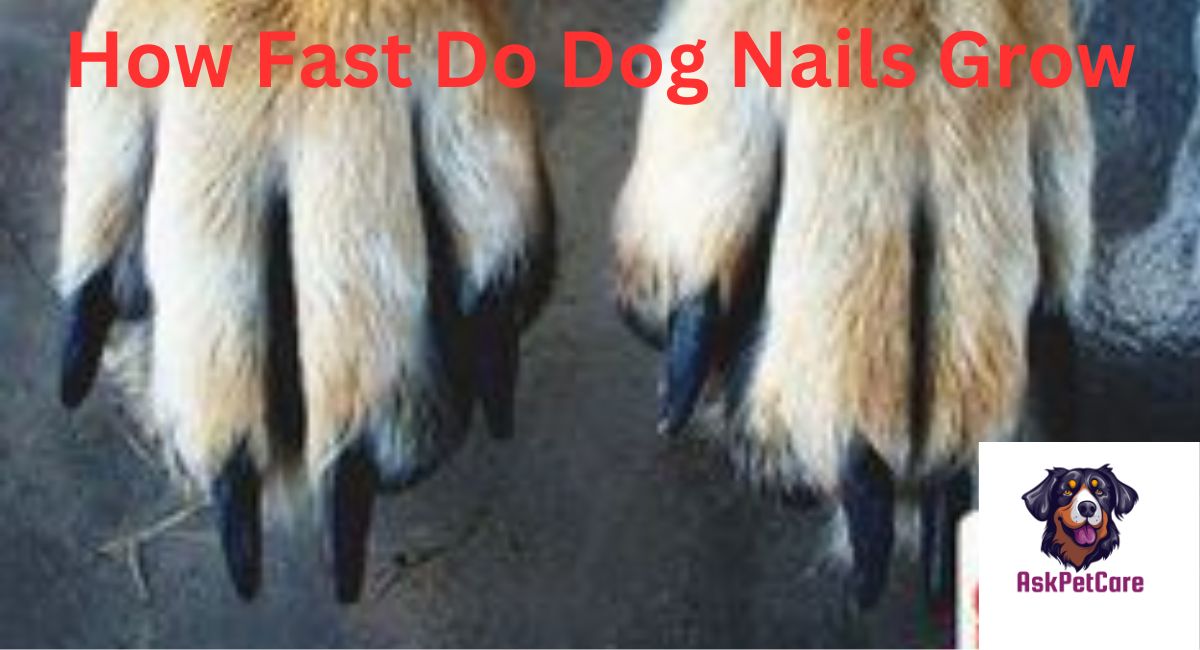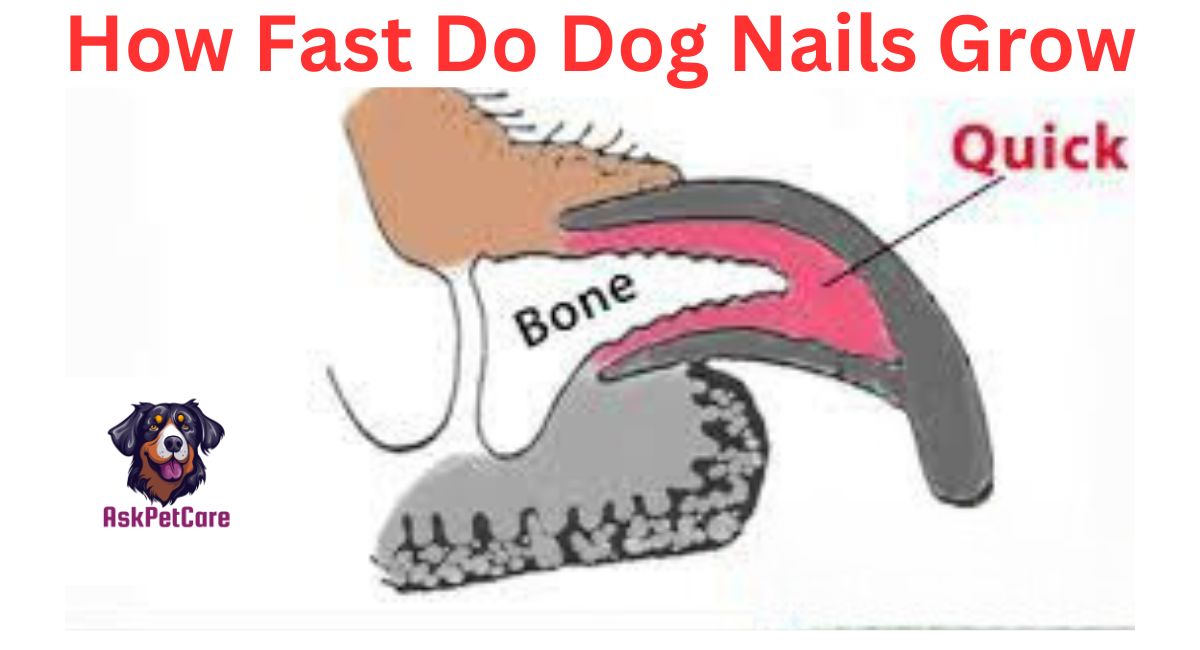Greetings to all fellow dog fans! I am Dr. Arif Aziz, in this blog post, I will explain briefly how fast do dog nails grow. I am a dedicated veterinarian with over 14 years of experience running my pet clinic. As a passionate dog lover and proud owner of two canine companions since their puppyhood, I am thrilled to address your query about the speed at which dog nails grow. how fast do dog nails grow?

For those of you in a rush, here’s a concise answer: dog nails tend to grow faster during their early stages of life rather than in their later years. However, the rate of nail growth is influenced by many factors, and I’m here to provide you with a comprehensive understanding based on my practical knowledge and hands-on experience.
Dog Nail Growth: Understanding its Importance for Pet Owners
As pet owners, we often focus on feeding our dogs the right food, giving them plenty of exercise, and showering them with love and attention. But there’s one aspect of their care that sometimes gets overlooked their nails.
Have you ever noticed how dogs’ nails seem to grow quickly? Just like our own nails, dog nails need regular attention to keep them at a healthy length. But why is this so important?
Well, imagine walking around in shoes that are too tight. Ouch, right? That’s kind of what it’s like for dogs when their nails get too long. It can be uncomfortable and even painful for them to walk or run, especially on hard surfaces like pavement.
But it’s not just about comfort; it’s about health too. When a dog’s nails are too long, they can start to curl under and dig into the paw pads. This can lead to infections and other problems that nobody wants their furry friend to deal with.
So, as responsible pet owners, it’s up to us to make sure our dogs’ nails stay at the right length. But how fast do dog nails actually grow, and what factors can affect their growth rate? Let’s take a closer look.
Section 1: Anatomy of Dog Nails: an overview of the structure and composition of dog nails.
Have you ever taken a close look at your dog’s nails? They might seem simple, but there’s more to them than meets the eye.
Structure and Composition: Dog nails, also called claws, are made of a tough protein called keratin. This is the same stuff that makes up our own nails and even our hair. Keratin gives nails their strength and durability.
If you look closely at a dog’s nail, you’ll notice that it’s not just one solid piece. It’s actually made up of different layers, kind of like an onion. These layers provide extra protection and support for the nail.
Role of the Quick: Now, let’s talk about something called the “quick.” The quick is like the living part of the nail. It’s made up of blood vessels and nerves that run through the center of the nail.
The quick is really important because it’s what supplies the nail with nutrients and oxygen to keep it healthy and growing. It’s also why you have to be careful when trimming your dog’s nails. If you cut into the quick, it can cause bleeding and pain for your pup.
Differences Between the Nail Bed and the Quick: You might have heard people talk about the nail bed and the quick like they’re the same thing, but they’re actually different.
The nail bed is the area underneath the nail where it attaches to the toe. It’s kind of like the foundation that supports the nail. The quick, on the other hand, is the part inside the nail itself.
Think of it like this: the nail bed is the ground floor of a building, and the quick is like the basement underneath. They’re connected, but they serve different purposes.
Understanding the anatomy of dog nails helps us appreciate how amazing these little structures are and why it’s so important to take good care of them.
Section 3: Average Nail Growth Rate: statistics on the average rate of nail growth in dogs.
Ever wonder how fast your dog’s nails grow? It’s not something we think about every day, but understanding it can help us take better care of our furry friends.
Average Nail Growth Rate: On average, a dog’s nails grow about 1/16 to 1/8 of an inch per month. That might not sound like much, but it adds up over time!
Of course, every dog is different, so some might have faster-growing nails than others. Factors like breed, age, and overall health can all play a role in how quickly a dog’s nails grow.
Guidelines for Trimming: So, how do you know when it’s time to trim your dog’s nails? Well, there are a few signs you can look out for:
- Clicking Sound: If you hear a clicking sound when your dog walks on hard surfaces, it might be a sign that their nails are too long and need trimming.
- Visible Length: Take a close look at your dog’s nails. If you can see them sticking out past the paw pads, it’s probably time for a trim.
- Paw Comfort: Pay attention to how your dog walks and stands. If they seem uncomfortable or hesitant to put weight on their paws, it could be because their nails are too long.
As a general rule of thumb, aim to trim your dog’s nails every 2-4 weeks to keep them at a healthy length. But remember, every dog is different, so you might need to adjust your trimming schedule based on your pup’s individual needs.
By staying aware of your dog’s nail growth rate and knowing when it’s time for a trim, you can help keep your furry friend happy, healthy, and comfortable.
Section 4: Monitoring and Maintenance: nail growth and recognizing signs of overgrowth or issues.
Keeping an eye on your dog’s nails might not seem like the most exciting part of pet ownership, but it’s actually really important for their health and happiness. Here’s why:
Importance of Regular Nail Maintenance: Regular nail maintenance is crucial for your dog’s comfort and well-being. When nails get too long, they can cause discomfort and even pain for your furry friend. Long nails can also lead to other issues like infections and difficulty walking.
Tips for Monitoring Nail Growth: Luckily, keeping an eye on your dog’s nails is pretty easy once you know what to look for. Here are some tips:
- Check regularly: Take a look at your dog’s nails every week or so to see how they’re doing. Look for signs of overgrowth, like nails sticking out past the paw pads.
- Listen for clues: Pay attention to the sound your dog’s nails make when they walk on hard surfaces. If you hear a clicking sound, it could mean their nails are too long and need trimming.
- Watch their behavior: Keep an eye on how your dog walks and stands. If they seem uncomfortable or hesitant to put weight on their paws, it might be because their nails are too long.
Guidance on Safe and Effective Nail Trimming Techniques:
Trimming your dog’s nails might seem intimidating at first, but with the right technique, it’s actually pretty straightforward. Here’s how to do it safely and effectively:
- Use the right tools: Invest in a good pair of dog nail clippers that are specifically designed for the task. Human nail clippers can be too small and can crush the nail, causing pain.
- Take it slow: If you’re new to nail trimming, start slow and gradually work your way up. You can start by just trimming a tiny bit off the tip of each nail and then gradually trim more as you get more comfortable.
- Be careful of the quick: Remember the quick we talked about earlier? It’s the living part of the nail, so you want to be careful not to cut into it. If you’re unsure where the quick is, it’s better to err on the side of caution and just trim a little bit at a time.
By keeping an eye on your dog’s nails, knowing what signs to look for, and using safe trimming techniques, you can help keep your furry friend happy, healthy, and comfortable.
Section 5: Addressing Abnormal Nail Growth: Identify potential health issues associated with abnormal nail growth.
When it comes to our furry companions, even their nails can give us clues about their overall health. Here’s what to watch out for when it comes to abnormal nail growth:
Potential Health Issues: Abnormal nail growth in dogs can be a sign of underlying health issues. Some potential problems include:
- Infections: Long nails can sometimes harbor bacteria and fungi, leading to infections in the nail bed or surrounding tissues.
- Ingrown Nails: Nails that grow into the paw pads can cause pain, swelling, and even infection if left untreated.
- Trauma: Damage to the nail, such as cracking or splitting, can occur due to injury or trauma, leading to discomfort and potential infection.
When to Seek Veterinary Attention:
If you notice any of the following signs, it’s best to seek veterinary attention for your dog’s nail-related concerns:
- Persistent limping or reluctance to put weight on a paw.
- Excessive bleeding or signs of infection around the nail.
- Changes in nail color, shape, or texture.
- Signs of pain or discomfort when touching or handling the paws.
- Any sudden or severe changes in nail growth or appearance.
Preventive Measures for Healthy Nail Growth:
To promote healthy nail growth and prevent potential issues, consider the following preventive measures:
- Regular Nail Trimming: Keep your dog’s nails trimmed to a healthy length to prevent overgrowth and reduce the risk of trauma or injury.
- Proper Nutrition: A balanced diet rich in essential nutrients, including protein and omega-3 fatty acids, can support healthy nail growth and overall paw health.
- Regular Exercise: Encourage regular exercise to help wear down nails naturally and promote good blood circulation to the nail bed.
- Paw Care: Keep your dog’s paws clean and dry to prevent bacterial or fungal infections that could affect nail health.
- Environmental Considerations: Avoid exposing your dog’s nails to harsh chemicals or abrasive surfaces that could damage or weaken them.
By staying vigilant for signs of abnormal nail growth, knowing when to seek veterinary attention, and taking preventive measures to promote healthy nail growth, you can help keep your dog’s paws in tip-top shape.
factors contribute to how fast do dog nails grow:
1-Age Matters
From what I’ve seen, younger dogs tend to have nails that grow faster than older dogs. This shows that we need to think about a dog’s age when deciding how often to take care of their nails.
2-Nutrition Plays a Key Role
What your pets eat affects how healthy and strong their nails are. A good diet with important stuff like biotin and omega-3 fatty acids helps nails grow strong. But if they don’t get the right nutrition, their nails might become weak and need more care.
3- Clinical Conditions and Health
As a seasoned veterinarian, I highlight the significance of a dog’s overall health in understanding nail growth. Certain medical conditions, hormonal imbalances, or metabolic disorders can impact the speed of nail growth. Regular veterinary check-ups are essential for identifying and addressing any underlying health issues.
4-Breed-Specific Factors
Different types of dogs have different nail growth speeds. Bigger dogs might have slower-growing nails, while smaller dogs like mine may need their nails trimmed more often because they grow faster.
5-Environmental and Atmospheric Conditions
The environment in which a dog is located also plays a role. Dogs that spend more time on rough surfaces, such as concrete or asphalt, may naturally experience slower growth due to wear and tear. Conversely, dogs in softer environments might require additional attention.
6-Genetics and Individual Variations
Each dog is unique, and genetic factors play a role in determining the rate of nail growth. Dogs from the same breed may still exhibit individual variations in the speed at which their nails grow. Recognizing and respecting these individual differences is crucial for tailoring nail care routines.
7-Hormonal Changes
When hormones change, like during puberty or pregnancy, it can affect how fast nails grow. Female dogs might see differences in nail growth during their reproductive cycles.
8-Nail Trimming Habits
How often and how we trim nails also affects how fast they seem to grow. If we trim them regularly and correctly, it can seem like they grow slower because they stay a good length.

Nail growth rate by month…. how fast do dog nails grow
| Age/month | Average nail growth rate |
| | 0-6 | Faster growth, requiring more frequent trims |
| | 6-12 | Moderately fast growth |
| | 12-18 | Gradual slowing of growth |
| | 18-24 | Slower growth, approaching the adult rate |
| | 24+ Adult rate of growth, generally slower | |
Nail growth rate by week. How fast do dog nails grow?
| Weeks | | Nail Growth Rate |
| 0-4 | Rapid growth may need frequent trims |
| 4-8 | Continued rapid growth |
| 8-12 | Moderate growth |
| 12-16 | Gradual slowing of growth |
| 16-20 | Slower growth, approaching the adult rate |
| 20+ Adult rate of growth, generally slower | |
9-Stress and Anxiety:
When dogs feel stressed or anxious, it can affect how their nails grow. They might start licking or chewing their paws too much, which can change how their nails look and feel.
10-Regular Exercise:
Exercise regularly isn’t just good for dogs’ overall health; it also affects how fast their nails grow. If they play and run around a lot, especially on different surfaces, it can naturally wear down their nails and change how fast they grow.
11-Seasonal and Climate Variations:
Different weather can change how fast a dog’s nails grow. Dogs might see differences in growth depending on things like how humid it is or how hot or cold it is outside.
12-Grooming Products and Techniques:
Using grooming stuff and doing it right can keep nails healthy and growing well. Putting lotion on them often and cutting them the right way can help them grow at a good speed.
12. Medication and Treatments
Certain medications or treatments prescribed for other health conditions can indirectly affect nail growth. It’s essential to be aware of any side effects that may influence the condition and growth rate of the nails.
13: Quality of Living Environment
Dogs in enriched living environments, where they have access to various stimuli and experiences, may exhibit healthier overall conditions, including nails. The quality of their living environment can contribute to overall well-being, influencing nail growth.
Do dog nails grow back after being ripped off?
Yes, dog nails can grow back after being ripped off, but it may take some time. The speed of regrowth depends on various factors, such as the dog’s health, age, and nail care. It’s important to keep the area clean and monitor for any signs of infection during the healing process.
Dog breeds with fast-growing nails:
Some dog breeds are known to have faster-growing nails compared to others. Breeds like Labrador Retrievers, Beagles, and Dachshunds often have nails that grow relatively quickly, requiring more frequent trimming and maintenance.
Do dog nails grow from the top or bottom?
Dog nails grow from the bottom, which is the part that extends from the nail bed. As the nail grows, it pushes outward from the nail bed towards the tip, gradually lengthening the visible part of the nail.
Where is the quick on black dog nails?
The quick-in-black dog nails are located inside the nail, just like in lighter-colored nails. However, it can be more challenging to see in dark nails. It’s crucial to exercise caution and trim small amounts at a time to avoid cutting into the quick, which can cause bleeding and discomfort for the dog.

To put it simply, how fast do dog nails grow is influenced by various factors such as age, diet, health, breed, and surroundings. I hope sharing what I’ve learned from experience helps you take better care of your furry pals’ nails. If you ever need more advice or have questions, don’t hesitate to reach out!
How often should you trim your dog’s nails?
It depends on your dog’s breed, age, and how active they are. Usually, it’s good to trim their nails every 2-4 weeks.
Do dogs’ quicks grow along with their nails?
Yes, the quick, which is the sensitive part of the nail with blood vessels and nerves, grows with the nail. Trimming regularly helps keep it in check and prevents it from getting too long.
Do long nails hurt dogs?
Yes, long nails can bother dogs. They might feel uncomfortable when walking because the nails put pressure on their joints. Long nails can also lead to problems like ingrown nails, which can make it hard for them to move comfortably.
Is it painful if you trim a dog’s nail too short?
Yes, it can hurt if you cut a dog’s nail too short because you might cut into the sensitive quick. This can make it bleed and hurt the dog. Be careful when trimming nails, and if they bleed, use a special powder to stop it.
if you like to understand the anatomy of dog,s claw you can read my article.
Here are some reference books that are considered authoritative on the topic of dog care, including nail care.
- “The Complete Dog Owner’s Manual” by Dr. Bruce Fogle
- “The Ultimate Guide to Dog Care: Everything You Need to Know to Keep Your Dog Happy and Healthy” by Amy Marder and Andrew Luescher
